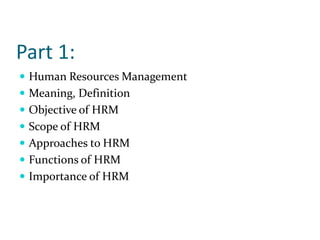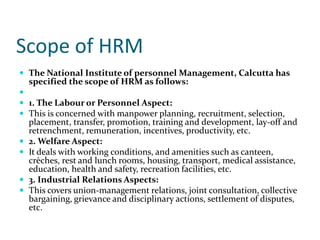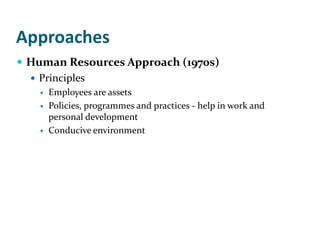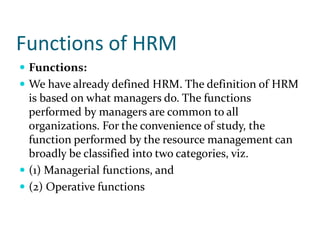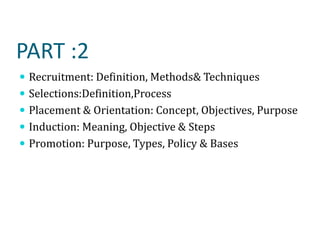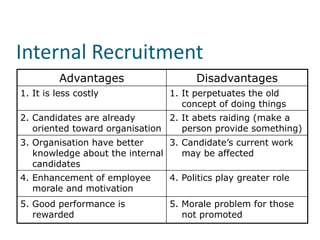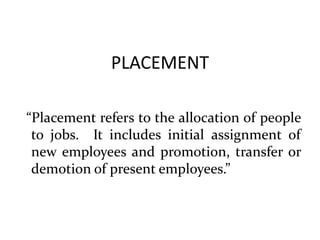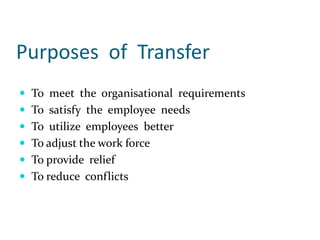Human Resource Management
- 1. Rahul Mahida Assistant Professor Faculty of Social work. PU
- 2. Part 1: Human Resources Management Meaning, Definition Objective of HRM Scope of HRM Approaches to HRM Functions of HRM Importance of HRM
- 3. HRM Meaning and Definition In common parlance, human resources means the people. However, different management experts have defined human resources differently. For example, •Michael J. Jucius has defined human resources as “a whole consisting of inter- related, inter-dependent and interacting physiological, psychological, sociological and ethical components”.
- 4. Meaning and Definition According to Leon C. Megginson “From the national point of view human resources are knowledge, skills, creative abilities, talents, and attitudes obtained in the population; whereas from the view-point of the individual enterprise, they represent the total of the inherent abilities, acquired knowledge and skills as exemplified in the talents and aptitude of its employees”.
- 5. HRM Meaning and Definition Organizations does not only consist of building, machines or inventories. It is people they manage and staff the organization HRM applies management principles in procuring, developing, maintaining people in the organization. Aims at integrated decision making and decisions on different aspects of employees are consistent with other HR decisions HR Decisions must influence effectiveness of the organization leading to better service to customer and high quality product and services at reasonable price. It is not confined to business establishment only, HRM is applicable also to the non business organization, like government department, education, health care etc.
- 6. Definition Human Resource Management is a series of integrated decisions that form the employment relationship; their quality contributes to the ability of the organisations and the employees to achieve their objectives. - Milkovich and Boudreau
- 7. Definition Human Resource Management is concerned with the people dimension in management. Since every organization is made up of people, acquiring their services, developing their skills, motivating them to higher levels of performance and ensuring that they continue to maintain their commitment to the organization are essential to achieving organizational objectives. This is true regardless of the type of organization – government, business, education, health, recreation or social action. -David A. Decenzo and Stephen P. Robbins
- 8. Definition Human Resource Management is the planning, organising, directing and controlling of the procurement, development, compensation, integration, maintenance and separation of human resources to the end that individual, organisational, and social objectives are accomplished. - Edwin B. Flippo In simple words, HRM is a process of making the efficient and effective use of human resources so that the set goals are achieved. Let us also consider some important definitions of HRM.
- 9. Objectives of HRM The primary objective of HRM is to ensure the availability of right people for right jobs so as the organisational goals are achieved effectively. This primary objective can further be divided into the following sub-objectives: 1. To help the organisation to attain its goals effectively and efficiently by providing competent and motivated employees. 2. To utilize the available human resources effectively. 3. To increase to the fullest the employee’s job satisfaction and self- actualisation. 4. To develop and maintain the quality of work life (QWL) which makes employment in the organisation a desirable personal and social situation. 5. To help maintain ethical policies and behaviour inside and outside the organisation. 6. To establish and maintain cordial relations between employees and management. 7. To reconcile individual/group goals with organisational goals.
- 10. Werther and Davis have classified the objectives of HRM into four categories as shown in table
- 11. Scope: The scope of HRM is, indeed, very vast and wide. It includes all activities starting from manpower planning till employee leaves the organisation. Accordingly, the scope of HRM consists of acquisition, development, maintenance/retention, and control of human resources in the organisation (see figure below). The same forms the subject matter of HRM. As the subsequent pages unfold, all these are discussed, in detail, in seriatim.
- 13. Scope of HRM
- 14. Scope of HRM The National Institute of personnel Management, Calcutta has specified the scope of HRM as follows: 1. The Labour or Personnel Aspect: This is concerned with manpower planning, recruitment, selection, placement, transfer, promotion, training and development, lay-off and retrenchment, remuneration, incentives, productivity, etc. 2. Welfare Aspect: It deals with working conditions, and amenities such as canteen, crèches, rest and lunch rooms, housing, transport, medical assistance, education, health and safety, recreation facilities, etc. 3. Industrial Relations Aspects: This covers union-management relations, joint consultation, collective bargaining, grievance and disciplinary actions, settlement of disputes, etc.
- 15. Approaches Scientific Management Approach (mid 1900s) Study of motion and fatigue ‘one-best-way’ to accomplish the task Piece-rate system Welfare programmes Failed to bring behavioural changes and increase in productivity Human Relations Approach (1930-40) Effect of social and psychological factors Relations and respect High Productivity
- 16. Approaches Human Resources Approach (1970s) Principles Employees are assets Policies, programmes and practices - help in work and personal development Conducive environment
- 17. Functions of HRM Functions: We have already defined HRM. The definition of HRM is based on what managers do. The functions performed by managers are common to all organizations. For the convenience of study, the function performed by the resource management can broadly be classified into two categories, viz. (1) Managerial functions, and (2) Operative functions
- 18. Functions of HRM Managerial Planning Organizing Staffing Directing Controlling
- 19. Functions of HRM Operational Employment HR Planning Recruitment Selection Placement Induction HR Development Performance Appraisal Training Management Development Career Planning and Development Compensation Mgt Job Evaluation Wage and Salary Admn Incentives Bonus Fringe Benefits Employee Relations
- 20. (1) Managerial Functions: PLANNING: Planning is a predetermined course of actions. It is a process of determining the organisational goals and formulation of policies and programmes for achieving them. Thus planning is future oriented concerned with clearly charting out the desired direction of business activities in future. Forecasting is one of the important elements in the planning process. Other functions of managers depend on planning function. ORGANISING: Organising is a process by which the structure and allocation of jobs are determined. Thus organising involves giving each subordinate a specific task establishing departments, delegating authority to subordinates, establishing channels of authority and communication, coordinating the work of subordinates, and so on.
- 21. STAFFING: This is a process by which managers select, train, promote and retire their subordinates This involves deciding what type of people should be hired, recruiting prospective employees, selecting employees, setting performance standard, compensating employees, evaluating performance, counselling employees, training and developing employees. DIRECTING/LEADING: Directing is the process of activating group efforts to achieve the desired goals. It includes activities like getting subordinates to get the job done, maintaining morale motivating subordinates etc. for achieving the goals of the organisation. CONTROLLING: It is the process of setting standards for performance, checking to see how actual performance compares with these set standards, and taking corrective actions as needed.
- 22. (2) Operative Functions: The operative, also called, service functions are those which are relevant to specific department. These functions vary from department to department depending on the nature of the department Viewed from this standpoint, the operative functions of HRM relate to ensuring right people for right jobs at right times. These functions include procurement, development, compensation, and maintenance functions of HRM. PROCUREMENT: It involves procuring the right kind of people in appropriate number to be placed in the organisation. It consists of activities such as manpower planning, recruitment, selection placement and induction or orientation of new employees. DEVELOPMENT: This function involves activities meant to improve the knowledge, skills aptitudes and values of employees so as to enable them to perform their jobs in a better manner in future. These functions may comprise training to employees, executive training to develop managers, organisation development to strike a better fit between organisational climate/culture and employees.
- 23. DEVELOPMENT: This function involves activities meant to improve the knowledge, skills aptitudes and values of employees so as to enable them to perform their jobs in a better manner in future. These functions may comprise training to employees, executive training to develop managers, organisation development to strike a better fit between organisational climate/culture and employees. COMPENSATION: Compensation function involves determination of wages and salaries matching with contribution made by employees to organisational goals. In other words, this function ensures equitable and fair remuneration for employees in the organisation. It consists of activities such as job evaluation, wage and salary administration, bonus, incentives, etc. MAINTENANCE: It is concerned with protecting and promoting employees while at work. For this purpose virus benefits such as housing, medical, educational, transport facilities, etc. are provided to the employees. Several social security measures such as provident fund, pension, gratuity, group insurance, etc. are also arranged. It is important to note that the managerial and operative functions of HRM are performed in conjunction with each other in an organisation, be large or small organisations. Having discussed the scope and functions of HRM, now it seems pertinent to delineate the HRM scenario in India.
- 24. Importance of HRM Human Resource Management is important to all managers despite their various functions because of the following reasons- Hire the right person for the job Low attrition rate Ensure people do their best Time saved in not conducting useless interviews Avoid legal action for any discrimination Safety laws are not ignored Equity towards employee in relation to salary etc. Effective training Avoid unfair labour practices
- 25. PART :2 Recruitment: Definition, Methods& Techniques Selections:Definition,Process Placement & Orientation: Concept, Objectives, Purpose Induction: Meaning, Objective & Steps Promotion: Purpose, Types, Policy & Bases
- 26. Recruitment It is the process of finding and attracting capable applicants for employment. The process begins when new recruits are sought and ends when their applications are submitted. The result is pool of applicants from which new employees are selected.
- 27. Initiating the Recruitment Process Prior to initiating a recruitment procedure, the following matters should be considered: Clarification of the scope and skill sets required to successfully perform the duties of the position Review of the Job Fact Sheet or Position Description to ensure that the skills and abilities required coincide with the current expectations of the position. If they do not, then a position evaluation should be undertaken. Review of the compensation available to the position (i.e. salary and benefit plans, etc.) Analysis of the impact that the hiring will have on the budget
- 28. Factors Governing recruitment External factors Supply and demand Unemployment rate Labour Market Political Social Sons of soil Image Internal factors Recruitment policy HRP Size of the firm Cost Growth Expansion Recruitment
- 29. Building Pool of Candidate INTERNAL EXTERNAL
- 30. SOURCES OF RECRUITMENT Current Employee References from present employee Databank of former applicants Retired Employee Former employee • Advertising • Employment agencies • Temporary help • Executive recruiters • Referrals and walk-ins • College recruiting • Company’s web site • Free and fee-paying Website services INTERNAL EXTERNAL
- 31. Recruiting Yield Pyramid It is the historical arithmetic relationships between- Recruitment leads and invitees Invitees and interviews Interviews and offers made Offers made and offers accepted
- 32. 50 100 150 200 1200 Leads generated (6:1) Candidates invited (4:3) Candidates interviewed (3:2) Offers made (2:1) New hires Recruiting Yield Pyramid
- 34. Internal Recruitment Advantages Disadvantages 1. It is less costly 1. It perpetuates the old concept of doing things 2. Candidates are already oriented toward organisation 2. It abets raiding (make a person provide something) 3. Organisation have better knowledge about the internal candidates 3. Candidate’s current work may be affected 4. Enhancement of employee morale and motivation 4. Politics play greater role 5. Good performance is rewarded 5. Morale problem for those not promoted
- 35. External Recruitment Advantages Disadvantages 1. Benefits of new skill, new talent and experiences to organisation 1. Better morale and motivation associated with internal recruiting is denied to the organisation 2. Compliance with reservation policy becomes easy 2. It is costly 3. Scope of resentment, jealousies and heartburn are avoided 3. Chances of creeping in false positive or false negative error
- 36. Selection Selection is the process of differentiating between applicants in order to identify those with a greater likelihood of success in a job. The selection of a candidate with the right combination of education, work experience, attitude, and creativity will not only increase the quality and stability of the workforce, it will also play a large role in bringing management strategies and planning to fruition.
- 37. Factors affecting selection External environment Supply and demand of specific skill Unemployment rate Legal and political considerations Company’s Image Internal environment Company’s policy HRP Cost of hiring
- 38. PROCESS OF SELECTION Preliminary Interview Selection tests Employment Interview Reference & background Selection Decision Medical Examination Job Offer Employment Contract Evaluation R E J C T E D
- 39. Basic Testing Concepts Generally tests are administered to determine the applicant’s .. Ability Test: Helps to determine how well one can perform his task Aptitude Test: Helps to determine how well one can perform his task Personality Test: To measure a prospective employee’s motivation to function in a particular working environment Interest Test: To measure an individual’s activity preferences. (For career change or when there is multiple career option available)
- 40. ORIENTATION - DEFINITION “ Orientation is the planned introduction of new employees to their jobs, their co- workers and the organization.”
- 41. PURPOSE • Making employees comfortable • Reduce their anxiety • Adjust themselves to the new environment • Providing them information about their job
- 42. ORIENTATION PROGRAMME Formal Informal Individual Collective Serial Disjunctive Investiture Divestiture
- 43. Formal : the management has a structured programme which is executed when new employees join the firm. Informal : new hires are directly put into job and they are expected to do the work themselves. Individual : It is orienting each person individually. It is more likely to preserve individual differences and perspectives. Collective : It is orienting people in a group. Most of the large firms tend to do this approach. Serial : orientation becomes serial when an experienced person inducts a new hire. Disjunctive : It becomes disjunctive when the new hire do not have any predecessors available for them. Investiture : It seeks to ratify the usefulness of the characteristics that the person brings to the new job. Divestiture : It seeks to make minor modifications in the characteristics of the new hire, though he or she was selected based on his or her potential.
- 44. FORMAL ORIENTATION PROGRAMME HR representative Supervisor Placement Organisation al issues and Employee benefits Specific Job location and Duties Special Anxiety reduction seminars
- 45. PLACEMENT “Placement refers to the allocation of people to jobs. It includes initial assignment of new employees and promotion, transfer or demotion of present employees.”
- 46. EMPLOYEE PLACEMENT Staffing needs are met in two ways: new hires from outside the firm and a reassignment of current employees, which may be referred to as in placement. PLACEMENT: Placement is the assignment or reassignment of an employee to a new job. most placement decisions are made by line managers. TYPES OF PLACEMENT PROMOTIONS TRANSFERS DEMOTIONS
- 47. Promotions A promotion occurs when an employee is moved from a job to another position that is higher in pay, responsibilities and/or organizational level. Transfers: they occur when an employee is moved from one job to another position that is relatively equal in pay, responsibility and/or organizational level. Demotions: they occur when an employee is moved from one job to another position that is lower in pay, responsibility and/or organizational level. TYPES OF PLACEMENT
- 48. • First developed in early 1970’s in the U.S. • Next to Selection and Placement. • Brief introduction about the organization. • Rehabilitated in the changed surroundings. • Welcoming Process. • Also called Orientation programme. • Used by prominent Indian companies like Taj group of Hotels, Citibank, HUL, P&G and many more. Induction
- 49. Definition Planned introduction of employees to their jobs, co workers and the organization. The process of receiving and welcoming an employee when he first joins a company and giving him the basic information he needs to settle down quickly and happily and start work. - Michael Armstrong
- 50. Objectives • To intimate them about the Mission, Aims and Objectives of the Company. • To general information about terms and conditions of employment.. • To Stimulate Interest. • Provides Information. • To give a clear understanding of their roles and responsibilities. • Minimizes reality shock. • To Communicate the details of the job requirements
- 51. Promotion
- 52. Advantages of promotions Promotion ,paves the way for employee self employment . It enhances employee to use his knowledge and skills. It inspires employees to compete and get ahead of others. It encourages them to remain royal and commited to their jobs and the organisation .
- 53. Bases of Promotion Merit – based Promotions Seniority –based Promotions
- 54. Merit-based Promotions Advantages – • It motivates employees to work hard, improve their knowledge, acquire new skills and contibute to organisational efficiency. • It helps the employer to focous attention on talented people, recognise and reward their meritorious contributions in an appropriate way .
- 55. Limitations - Personal prejudices ,biases and union pressures may come in the way of promoting the best performer. When young employee s get ahead of the senior employees in an organisation , they may fell insecure and may even quit the organisation.
- 56. Security-based Promotions Advantages – • It is easy to measure the length of service and judge the seniority . • There is no scope for favoritism, discrimination and subjective judgement .
- 57. Limitations - It demotivates the young and more competent employees and results in greater employee turnover. It kills the zeal and interest to develop , as everybody will be promoted without showing any all-round growth or promise.
- 58. Promotion Policy Establish a fair and equitable basis for promotion (merit or seniority or both ) Appropriate authority should be entrusted with the responsibilty of taking a final decision on promotion. Detailed records of services , performances , etc. , should be maintained for all employees , inspective of their background .
- 59. Transfer
- 60. A transfer is a horizontal or lateral movement of an employee from one job, section, department, shift plant or position to another at some other place where salary, status and responsibility are usually the same. Transfer is defined as “a lateral shift causing movement of individuals from one position to another usually without involving any kind of change in duties, responsibilities, skills needed or compensation”.
- 61. Purposes of Transfer To meet the organisational requirements To satisfy the employee needs To utilize employees better To adjust the work force To provide relief To reduce conflicts
- 62. Production Transfer: Such transfers are resorted to when there is a need of manpower in one department and surplus manpower in another department. Such transfers are made to meet the company requirements. Replacement Transfers: Replace an existing employee who has been in the organization for a long time with a new employee and thereby giving some relief to an old employee from the heavy pressure of work. Remedial Transfers: As the name suggest, these transfers are made to rectify the situation caused by faulty selection and placement procedures. Such transfers are made to rectify mistakes in placement and recruitments. Versatility Transfer: Such transfers are made to increase versatility of the employees in more than one job and department. This type of transfer, also referred to as ‘Job Rotation’ is a tool to train employees. Types of Transfer
- 63. Shift Transfers: are transfers of workers from one shift to another on the same type of work. Workers generally dislike second or third shift as it affects their participation in community life. Selection Transfers: they are made within the department or section. It is to be train the workers and prepare them to handle different types of operations within the department. Departmental Transfers: transferring from one department to another department within the plants. Inter-Plant transfers: if there is more than one plant under the control of same management transfer may be made from one plant to another for varied reasons. Such transfers are called inter- plant transfers.
- 64. Benefits of Transfer Improve employees skills Reduce monotony boredom Remedy faulty placement decisions Prepared the employees for challenging assignments Improve employees satisfaction and morale Improve employer –employee relations
- 65. Problems of Transfer Inconvenient to employees who otherwise don’t want to move . Employees may or maynot fit in the new location. Shifting of experienced hands may affect productivity. Discriminatory transfers may affect employee moral.
- 66. Transfer Policy Name of the superior who is authorized and responsible to initiate a transfer . The unit of the organization within which transfers will be administered. Reasons which will be considered for personal transfers , their order of priority etc. Reasons for mutual transfer of employees .
- 67. THANK YOUFor more content(related to social work and HRM/labour practice visit and follow https://www.Slideshare.Net/rahulmahida1 Presented by Rahul Mahida


